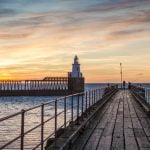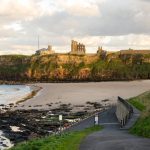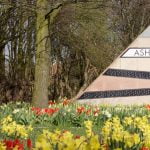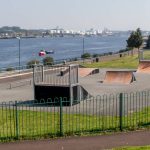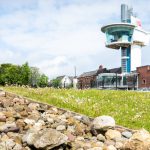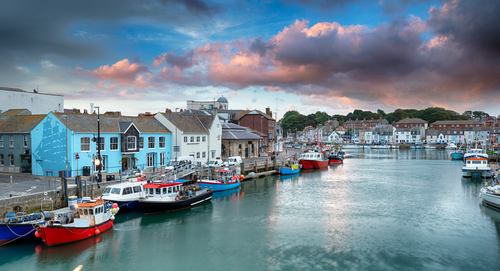
Weymouth in Brief
Weymouth is a seaside town in the county of Dorset, Southern England. Situated at the mouth of the River Wey on the English Channel, the town lies 7 miles (11 km) south of Dorchester and 5 miles (8 km) north of the Isle of Portland. While Weymouth has an extensive maritime heritage and a still sizeable fishing industry, the town’s economy is now largely dependent on tourism. The town is very much regarded as the gateway to the English Jurassic Coast, which has UNESCO world heritage site recognition. At the 2011 UK census, Weymouth had a recorded population of 52,323, making it the third-largest settlement in Dorset, after Bournemouth and Poole.
A Fleeting History
Early Times
The first known record mentioning Weymouth dates from around 1100. It gradually grew as a settlement to the south and west of the harbour as an outlying area of Wyke Regis. By the mid-13th century, it was established as a seaport and a chartered borough. Melcombe Regis developed as a separate settlement on a peninsula on the north side of the River Wey and was particularly renowned for the export of wool. In June 1348, it is thought that a sailor infected with the deadly Black Death came ashore at Melcombe Regis. He subsequently introduced the disease to Britain, with the Weymouth area being particularly devasted by the outbreak of the epidemic.
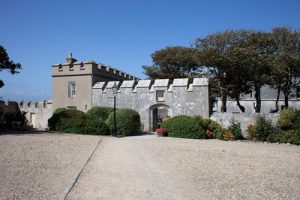
Portland Castle was built by Henry VIII
Tudor Times
In the 1530s, Henry VIII built two forts close to Weymouth at Sandsfoot Castle in Wyke Regis, and Portland Castle in Castletown, to protect the Dorset coast from invasion. By the 16th century, trade competition between Weymouth and its near neighbour Melcombe Regis had become intense. The bitter rivalry continued up until 1571 when Queen Elizabeth I duly granted a Royal Charter that united the two communities to create a single town. Despite Melcombe Regis being the larger of the two settlements, Weymouth was the name adopted for the newly created single borough.
In 1635, around 100 migrants set out from Weymouth on board the ship Charity to cross the Atlantic for the Americas. They went on to establish the settlement of Weymouth in Massachusetts. Later, further migrants from Weymouth would go on to found the likes of Weymouth, Nova Scotia and Salem, Massachusetts.
The English Civil War
In 1642, at the outbreak of the First English Civil War, Dorset found itself to be a county with divided loyalties. In general, the south of the county and the larger towns favoured the Parliamentarians, while the rural population and the north of the county gave their support to the Royalist cause. In August 1643, Weymouth was taken by the Royalists, but in 1644, it was then captured by Robert Devereux, 2nd Earl of Essex for Parliament. William Sydenham was appointed governor and by the autumn, he had garrisoned the town by the building of two forts.
However, at midnight on 9 February 1645, a small Royalist force crossed the narrow strait from Portland Castle to the town. They linked up with a group of sympathisers, who identified themselves by wearing a white handkerchief on their sleeve and with the use of the password “Crabchurch”. The incursion caught the larger Parliamentarian forces by surprise, with the Royalists successfully capturing both the Chapel and Nothe forts. The Parliament forces rallied and counter-attacked. However, the Royalists were able to hold the forts until reinforcements, under the command of Sir Lewis Dyve and the governor of Portland Castle, William Hastings, arrived the following day. The incident became known as the (First) Battle of Weymouth, being dubbed locally as the “Crabchurch Conspiracy”. A second battle took place on the 27th of February with the strengthened Parlimentarian forces retaking Weymouth, and eventually, both forts. The royalists involved in the conspiracy were rounded up, with most being executed.
Georgian Times
In 1702, the renowned architect Sir Christopher Wren was elected as the Member of Parliament for Weymouth. He had a financial interest in the nearby Portland’s quarries and stipulated the use of the renowned Portland stone for his most famous design, St Paul’s Cathedral in London. During the 18th century, in an attempt to reduce local consumption of booze and drunkenness amongst the masses, tax revenues were raised on alcohol. However, because of its close proximity to France, Weymouth along with much of coastal Dorset became a haven for smugglers. By the time of the French Revolution in 1789, smuggling reached its peak, with hundreds of thousands of gallons of French brandy, were coming ashore illegally every year. The area was supplying not just local markets but much of the country.
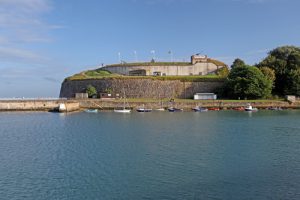
The imposing Nothe Fort, Weymouth
In 1780, the Duke of Gloucester, brother of King George III, built a grand residence in Weymouth, Gloucester Lodge. In 1789, King George III visited Weymouth for the first time and became somewhat charmed by the place. He enjoyed his outings to the town so much that he decided to purchase Gloucester Lodge from his brother. He continued to visit the town on a regular basis up until 1805. As a local tribute, in 1808, a mounted white horse representing the King was carved into the chalk hills on the outskirts of Osmington. The local conjecture was that the king wasn’t entirely happy with the carving since it showed him riding away from, rather than towards the town. Thus, in 1810, given the King’s influence in popularising Weymouth, the local authorities decided to erect a monument, ‘The Painted Statue’, in his honour, in the town itself. It was also in the Georgian period, that many of the terraced houses along Weymouth’s esplanade were constructed.
Victorian Times
Between 1860 and 1872, Nothe Fort was constructed by the military in order to protect Portland and Weymouth Harbours against possible attack. An indication of the area’s growing importance to the Royal Navy. In 1869, The Royal National Lifeboat Institution opened a lifeboat station in the town. In 1872, a dam was built to maintain the level of the water in the Inner Harbour and Radipole Lake, allowing the port to prosper. In the 1880s, Cosens and Company set up a steamer passenger service that took visitors to towns along the south coast. In 1887, one of Weymouth’s most famous landmarks, The Jubilee Clock, was erected on the esplanade to commemorate the 50th anniversary of Queen Victoria’s coronation.
The War Years
During World War 1, around 120,000 ANZAC survivors were billeted for convalescence in Weymouth after being injured at Gallipoli and other major battles.
In 1921, Westham Bridge was built to act as a tidal barrier for Radipole Lake, allowing the inner harbour to be used at all tide depths. It was opened to great fanfare by HRH Prince of York, who later became King George VI. The structure replaced the Backwater Bridge, which first spanned the ‘backwaters’ in 1859.
In 1930, Town Bridge was built, becoming the sixth bridge at the site since 1597. Linking Weymouth and Melcombe, it’s a lifting bascule bridge that allows boats to access the inner harbour. One of Weymouth’s most iconic structures, it’s Grade II listed.
In World War 2, Weymouth and Portland were bombed by German planes, which were looking to destroy Portland harbour’s large naval base. The town experienced a loss of 76 civilian lives throughout the WW2 campaign. On 23rd June 1940, the entire population of Alderney evacuated to Weymouth, following the German occupation of the Channel Islands. Also during WW2, the Bouncing Bomb was tested at the Fleet lagoon just to the west of town. More than half a million troops passed through Weymouth between June 1944 and June 1945. Many were on their way to Normandy, to join the allies, in the fight against German forces.
The Modern Era
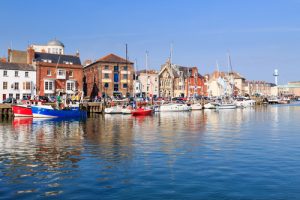
In 1960, Weymouth’s Pavilion Theatre was built on a peninsula of reclaimed land where the Ritz Theatre had previously stood, before being destroyed by fire in 1954. In 1974, the district of Weymouth and Portland was formed under the 1972 Local Government Act. Throughout the late 20th century, Weymouth’s harbour has continued to be important to the town, both for fishing and recreational purposes. In 1987, a hydrofoil service to the Channel Islands was introduced with a regular service being operated to both Jersey and Guernsey. The 2-hour trip to Guernsey is particularly popular with tourists.
In 1994–1996 and 2002, there was a two-phase refurbishment of the town’s inner harbour, which included a new marina with capacity for hundreds of berths for pleasure boats, cruisers and sailing boats. Additionally, Weymouth’s outer harbour hosts a large fishing fleet, which lands the largest annual catch in England, and third largest in the UK.
There are over two hundred events held throughout the Borough of Weymouth, each year. These occasions are as diverse as a firework festival, dragon boat racing, a beach volleyball competition, a handball tournament and a motocross event. Weymouth’s annual carnival, held in mid-August, attracts around 70,000 people each year. The international kite festival, which is held in May on Weymouth Beach, attracts around 40,000 spectators from around the world each year. There is also a flotilla of local boats offering fishing trips, diving trips and pleasure cruises, along the Jurassic Coast, and around the Isle of Portland.
Uniquely, Weymouth is the only place in the world to have hosted the start of the ‘Tall Ships Race’ on three separate occasions, i.e. in 1983, 1987 and 1994. It attracted some 300,000 spectators to the town on each occasion. In 2012 the town had the honour of hosting the Olympic and Paralympic sailing competitions, which was held at Weymouth Bay.
The District of Weymouth and Portland is twinned with the German town of Holzwickede, in North Rhine-Westphalia, and the French town of Louviers, in Normandy.
Getting there!
By car
From London and the South, follow the A35 towards Dorchester, before turning off at the junction for the A354. From the West Country, just follow the signs for Bridport, then take the A35 towards Dorchester, turning off at the junction with the A354.
By train
Trains to Weymouth are operated hourly from London Waterloo. From the North, you could change trains at either London or Bristol, Bournemouth or Southampton. The railway station is close to the beach and just a few minutes walk from the town centre.
By bus
National Express operates a coach service to and from Weymouth. Services run to the major destinations of London Victoria, Portsmouth, Bournemouth, Brighton, Bristol and Blackpool where connections to other destinations are possible. First runs regular services along the Jurassic Coast from Exeter and Poole.
By ferry
Condor Ferries operates a direct ferry service from Jersey and Guernsey. A connection can be made from St Malo (France) ferry at Jersey. The ferry terminal is only a few minutes walk from the town centre.
By air
Southampton Airport is approximately 1.5 hours from Weymouth by rail or road.
Getting Around!
Local bus services are run by First Hampshire & Dorset. Buses run from Weymouth to the Isle of Portland, Dorchester, Bournemouth, Wool, Beaminster, Axminster, as well as to local villages and the town’s holiday parks. Other bus services connect Weymouth to towns and villages along the Jurassic Coast by route X53, which is a total of 88 miles (142 km). The service is great for walkers who can connect with the long-distance South West Coast Path.
Weymouth F.C.
The local football team is Weymouth F.C. who are nicknamed ‘the Terras’. They are a semi-professional team who currently play in the National League South, the 6th tier of English football. Weymouth plays their home games at the Bob Lucas stadium.
Notable People
Notable people who were born or resided in Weymouth include:
- Thomas Hardy (1840 – 1928) – world-renowned author, lived and worked in Weymouth in 1869 and again 1871–72.
- Gerald Basil Edwards (1899 – 1976) – noted English novelist, spent the last years of his life in Weymouth.
- William Allen (1792 – 1864) – born in Weymouth, was an English naval officer (Rear-Admiral), explorer and Fellow of the Royal Society.
Things to see and do!
There plenty of great things to see and do around Weymouth, here’s a list of some of the town’s most popular tourist hotspots:
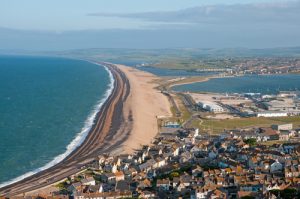
Chesil Beach forms part of Dorset’s Jurassic Coast
- Chesil Beach – an 18-mile long shingle beach stretching from West Bay to Portland forming part of the Jurassic Coast World Heritage Site.
- Weymouth Beach – a wide sandy beach just 5 minutes walk from town. It has the expected attractions of a traditional British holiday beach, including donkey rides, Punch & Judy shows, etc
- Portland Castle – is one of Henry VIII’s best-preserved forts, built in the late 1530s to protect against invasion. It’s now owned by English Heritage and Grade I listed building.
- Weymouth Harbour – is one of the UK’s finest and most scenic Georgian harbours. During the main holiday season, the bustling harbour is full of catamarans, fishing boats and yachts.
- Portland Bill Lighthouse – built in 1906, it’s arguably the UK most famous nautical lookout point. The 153 steps to the top give you a great panoramic view of the coast.
- Abbotsbury to Ferrybridge Walk – an 11-mile walk that starts in the historic village of Abbotsbury and follows the West Dorset Heritage Coast through woodland and rolling hills
- Radipole Lake – a lake on the River Wey, its also an RSBP nature reserve. Situated in the town’s Southill suburb, it features bird exhibits and programmes, trails and viewing points.
- Weymouth Sea-Life Adventure Centre – features more than a 1000 birds and sea creatures in both an indoor and outdoor environment. It also has adventure-themed play areas for kids.
- Alexandra Gardens – a family orientated place to enjoy some traditional British seaside entertainment. The gardens contain fairground rides, amusements and arcade games.
- Nothe Fort – completed in 1872, it’s one of the best-preserved forts of its kind and a major tourist attraction. Displays are over 3 floors, which chart the whole of the fort’s history.
Where to stay?
The main accommodation choices in Weymouth consist of hotels along on the seafront, guest houses around the town centre, and caravan and camping sites just out of town. Here is a rough guide to expected accommodation prices for 2 adults sharing:
Camping and Caravaning: Varies greatly depending on location, type of vehicle and the facilities offered
Guesthouse/B&B/Lodge: £60 – £100
Hotel: £100 – £200
Holiday homes (2-6 sharing): £150 – £200
